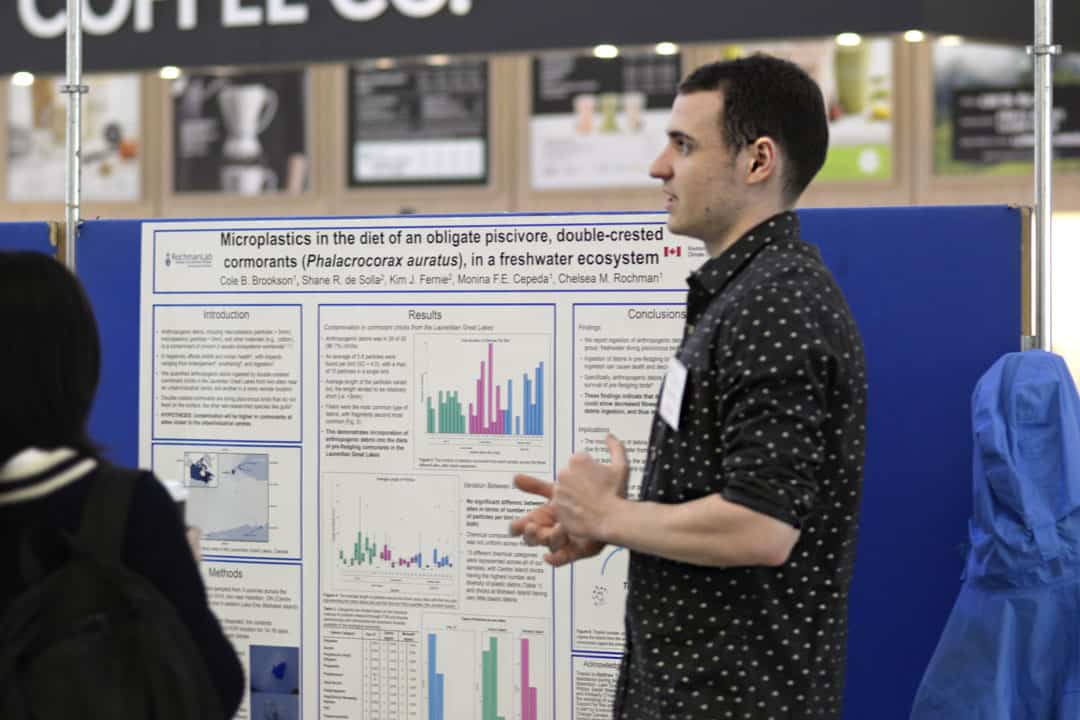The Arts & Science Students’ Union (ASSU) Undergraduate Research Conference took place in Sidney Smith Hall on Friday, January 25. The second annual conference brought together students from the natural sciences to the social sciences.
Students communicated the methods, results, and impact of their work by delivering talks and presenting posters to conference attendees.
In an interview with The Varsity, ASSU Executive Victoria Chen noted that the conference was valuable to both listeners and presenters.
For attendees, going to research talks enables them to learn about other disciplines. For presenters, delivering research talks enables them to develop their public speaking and science communication skills.
Highlighting environmental science research
In his opening remarks, Faculty of Arts & Science Dean David Cameron drew attention to research led by Ecology & Evolutionary Biology (EEB) undergraduate Cole Brookson.
Brookson presented his findings on microplastics — pieces of plastic less than five millimeters in size — which had been found in 87 per cent of the double-crested cormorants sampled in the Great Lakes. The cormorant is a species of seabird.
Brookson and his colleagues were surprised to find microplastics in the digestive systems of cormorants from an unexpectedly wide geographic range, from Hamilton Harbour to eastern Lake Michigan.
The high quantity of microplastics in the Great Lakes is especially concerning because its consumption can be deadly to seabirds, causing starvation due to a false perception of fullness. Digesting plastic can also cause hormonal problems.
While the results of Brookson’s study do not present direct risks to human health, they do demonstrate how improper plastic waste disposal can impact wildlife.
“Plastic can take hundreds to thousands of years to biodegrade, if it ever does at all,” said Brookson. “When you don’t manage your waste properly, when you don’t have effective mitigation strategies, you end up having this persistent pollutant that just never goes away.”
From health to human geography
Presenting his research findings on the hepatitis B virus (HBV), immunology major Seungwoo Lee explained how the introduction of lactose into donated white blood cells (WBCs) could reduce binding of the galectin protein to T cells, which are immune cells. These T cells attack HBV-infected cells that die off when galectin binds to them. In 10 per cent of HBV patients, binding has reduced the number and effectiveness of T cells, which could make them more susceptible to cancer. These findings could be used to mitigate the risk of developing cancer in some patients with HBV.
Lee showed that introducing lactose into human WBCs blocks the reception of galectin by T cells, boosting the number and effectiveness of T cells.
These findings could give rise to better treatment options for patients with HBV, and reduce their risk of developing cancer.
Neuroscience student Alexandra Kassikova showed how transforming the astrocyte brain cell into the oligodendrocytes brain cell could be a promising treatment option for multiple sclerosis.
Kristina van Veen, who studies human geography, showed how emojis are changing the way we communicate. She highlighted how emojis can take on unique interpretations within small social groups, and how their inclusion in text could lead to misinterpretation.
Evelyn Ullyott-Hayes — a student studying Middle Eastern civilizations — used a software program called JSesh to translate the Middle Egyptian text written on an artifact that is part of a collection in the Royal Ontario Museum.
Where art meets science
Patrick Fraser, a physics and philosophy specialist, spoke about how ghost imaging in experimental quantum physics may have implications for how we define the representation of objects.
In classical imaging, said Fraser, we visualize objects because the light reflecting off of them is registered by our eyes.
But in ghost imaging, using quantum optics, researchers are able to observe particles that are highly correlated to, yet physically distant from an object under study. These particles then let us create a precise image of the distant object.
Current philosophy contends that photos are “representative of the objects they depict in some direct contact mechanism,” but for this to stay true, only a small number of interpretations of quantum mechanics can remain true.
To accept a larger number of interpretations, said Fraser, we may have to dispose of this intuitive definition.
Disclosure: Tom Yun, former Managing Online Editor, was a moderator at the event. Ibnul Chowdhury, current Comment Editor, presented a talk on research at the event. Neither are directly mentioned in this article.


